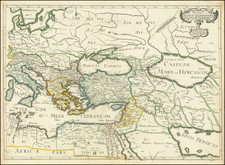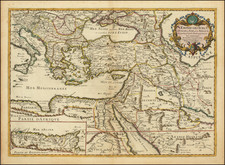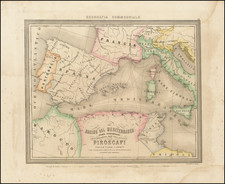Detailed map of the ancient Mediteranean regions, published by Du Val.
The map shows the Mediterranean world at around 48 BC. It is drawn from Pharsalia, a Roman epic poem by the poet Lucan, telling of the civil war between Julius Caesar and the forces of the Roman Senate led by Pompey the Great. The poem's title is a reference to the Battle of Pharsalus, which occurred in 48 BC, near Pharsalus, Thessaly, in northern Greece.
At the battle of Pharsalia, Caesar decisively defeated Pompey. Lucan was a young poet and writer under Emperor Nero. He is regarded as one of the outstanding figures of the Imperial Latin period, and his poem is widely considered the best epic poem of the Silver Age of Latin literature. This poem was apparently very popular during times of civil wars and similar strife, it was often republished with an introduction/comments of editor explaining how the poem relates to the current problems.
The Great Roman Civil War (49-45 BC), was one of the last politico-military conflicts in the Roman Republic before the establishment of the Roman Empire. It began as a series of political and military confrontations, between Julius Caesar, his political supporters and his legions, against the Optimates the politically conservative and socially traditionalist faction of the Roman Senate, who were supported by Pompey and his legions. Pharsalia by Lucan is an Epic of the major event in this civil war.
The Battle of Pharsalus was a decisive battle of the civil war. On 9 August 48 BC at Pharsalus in central Greece, Julius Caesar and his allies formed up opposite the army of the republic under the command of Pompey the Great. Pompey had the backing of a majority of the senators, of whom many were optimates, and his army significantly outnumbered the veteran Caesarian legions. \
The two armies confronted each other over several months of uncertainty. Caesar found himself isolated in a hostile country with about 28,800 men including auxiliaries and cavalry and also short of provisions. On the other side of the river he was faced by Pompey with an army more than twice as large in number.
Pompey wanted to delay, knowing the enemy would eventually surrender from hunger and exhaustion. But under pressure, he reluctantly engaged in battle and suffered an overwhelming defeat, ultimately fleeing the camp and his men, disguised as an ordinary citizen.
Caesar had won his greatest victory, claiming to have only lost about 230 men while killing between 6 and 15 thousand enemies. This victory did not end the war but it did give Caesar a much needed boost in legitimacy. Until then much of the Roman world outside of Italy supported Pompey and his allies due to the extensive list of clients he held in all corners of the Republic.
After Pompey's defeat former enemies began to align themselves with Caesar as some came to believe the gods favored him, while for others it was self-preservation. Pompey fled from Pharsalus to Egypt, where he was assassinated on the order of Pharaoh Ptolemy XIII, and Caesar won the war a few years later and established the Roman Empire as Dictator.
Pierre Duval (1618-1683) was a French geographer, cartographer, and publisher who worked in Abbeville and Paris during the seventeenth century. He was born in the former city, in northeast France, before moving to Paris. Duval was the nephew of the famous cartographer Nicolas Sanson, from whom he learned the mapmaker's art and skills. Both men worked at the royal court, having followed the royal request for artists to relocate to Paris. In addition to numerous maps and atlases, Du Val's opus also includes geography texts. He held the title of geographe ordinaire du roi from 1650 and died in 1683, when his wife and daughters took over his business.












![[The Travels of Paul] Tabula Geographica, in qua omnes regiones, urbes, oppida, et loca describuntur, quorum mentio fit in Actis et Epistolis Apostolotum, et Apocalypsi; de integro multis in locis emendata, ac regionum limitibus distincta, auct. Pet. Planc. . . .](https://storage.googleapis.com/raremaps/img/small/77970.jpg)
![[ Sicily / Sardinia ] Septima Europe Tabula](https://storage.googleapis.com/raremaps/img/small/101893.jpg)
![Tabula Aphricae II [shows Sicily and Sardinia]](https://storage.googleapis.com/raremaps/img/small/47363.jpg)